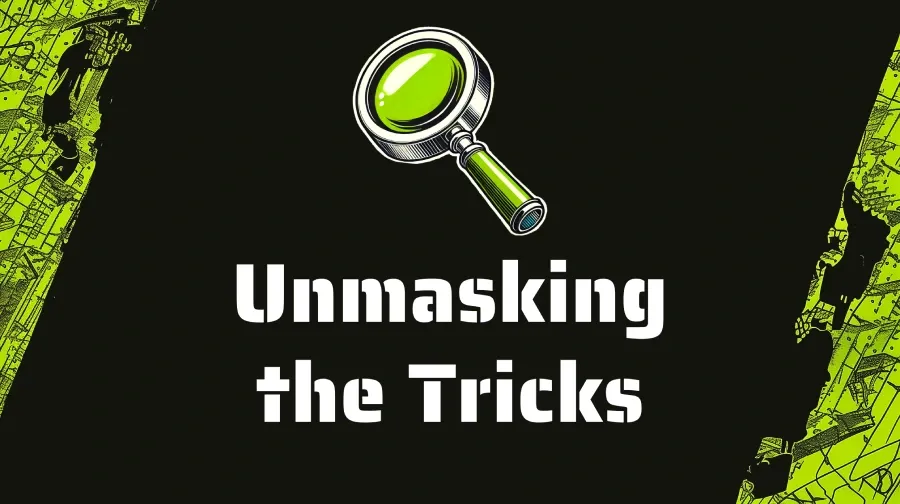Welcome to the ScamSniper blog! If you've ever felt like the internet is a minefield of trickery and deceit, you're not wrong. Scammers are the digital age's pesky mosquitoes—annoying, relentless, and occasionally leaving you itching for days. But fear not! At ScamSniper, we're armed with the ultimate bug spray to keep those little troublemakers at bay.
In this inaugural post, we'll dive deep into the murky waters of online scams. We'll expose the crafty tactics these rascals use, sprinkle in some laughs (because if you can't laugh at scammers, who can you laugh at?), and equip you with the knowledge to outsmart them at every turn. So grab a cup of coffee, settle in, and let's turn the tables on these digital scoundrels!
The Rise of Scams in the Digital Age: A Scammer's Paradise
Ah, the internet—a place where you can order a pizza, binge-watch cat videos, and apparently inherit millions from a Nigerian prince all in one afternoon. As our lives become more intertwined with the digital realm, scammers have found their playground. They're like the uninvited guests at a party, always looking for free food and someone to bother.
Did you know? In 2023 alone, consumers reported losing over $10 billion to fraud, a staggering increase from previous years. In fact, scams have become more sophisticated and widespread, with losses from investment scams leading the charge at $4.6 billion, followed closely by imposter scams, which racked up $2.7 billion in reported losses. These figures highlight just how deeply embedded scams have become in our daily lives.
But that's just the beginning. Globally, scams cost consumers and businesses a jaw-dropping $485.6 billion in 2023, with $151.1 billion of those losses occurring in the Americas alone. Payment fraud, cyber-enabled schemes, and bank fraud all contributed to this enormous figure, showing how widespread and damaging these activities have become.
These cyber tricksters have evolved from the obvious "You've won a million dollars!" emails to more sophisticated schemes that could fool even the savviest netizen. With advancements in technology, they've upped their game, but so have we. Let's peel back the curtain and see what these mischief-makers are up to.
Know Thy Enemy
Knowledge is power, and we're about to power up your scam-detecting abilities to superhero levels. Here are some of the most common tactics these digital delinquents use:
1. Phishing Emails: The Bait and Switch
These emails might look like they're from your bank, a popular retailer, or that long-lost friend who suddenly wants to share a Google Doc with you. Real-Life Example: Recently, scammers impersonated a well-known streaming service, sending emails claiming your account was suspended due to billing issues.
Tip: Always check the sender's email address. If it looks fishier than a seafood market, don't click any links! When in doubt, run it through our Scam Detector to be sure.
2. Fake Invoices: The Unexpected Bill
Receiving an invoice for something you never purchased is like getting a bill for a meal you didn't eat—annoying and confusing. Scammers hope you'll panic and pay up without thinking. Case Study: A small business owner received a convincing invoice for office supplies they never ordered, nearly paying hundreds of dollars unnecessarily.
Tip: Take a deep breath. Verify the invoice by contacting the company directly using official contact information—not the details provided in the suspicious email.
3. Impersonation Scams: The Wolf in Sheep's Clothing
"Grandma, it's me! I need bail money!" Unless you actually have a grandchild prone to questionable life choices, this is likely a scammer trying to tug at your heartstrings (and purse strings). Impact: Seniors lost over $1 billion to scams in 2020, with impersonation scams being a leading cause.
Tip: Always verify unexpected requests by contacting the person through a known channel. Scammers hate it when you do your homework.
4. Too-Good-To-Be-True Offers: The Shiny Bait
"Congratulations! You've won a luxury cruise!" Sure, and we're the Tooth Fairy. Scammers use enticing offers to lure you in, but remember, there's no such thing as a free lunch—or cruise, for that matter.
Tip: If it sounds too good to be true, it probably is. Before you pack your bags, check the offer using our Resources page to see if it's a known scam.
5. Tech Support Scams: The Unwanted Help
An unsolicited call or pop-up claiming your computer is infected and only they can save you—for a fee, of course. These scammers are the digital equivalent of a mechanic slashing your tires and then offering you a ride. Emerging Trend: Scammers now use deepfake voices to impersonate tech support agents.
Tip: Legitimate companies don't make unsolicited support calls. Hang up, don't click, and maybe give your actual antivirus software a quick scan.
6. Investment and Cryptocurrency Scams: The Modern Gold Rush
"Invest now and double your money in a week!" Unless you've got a DeLorean and a sports almanac from the future, steer clear of these promises. Warning: Cryptocurrency scams skyrocketed in recent years, with losses exceeding $80 million in the last six months alone.
Tip: Consult with a certified financial advisor before making any investments. And remember, even they can't predict the future (we've asked).
7. Social Media Scams: The Digital Wild West
From fake giveaways to imposter profiles, social media is rife with scam opportunities. Example: A popular scam involves fake customer support accounts asking for your login details.
Tip: Be cautious of unsolicited messages and never share personal information over social media. Verify accounts before engaging.
8. Mobile App Scams: The Trojan Horses
Fake apps can look legitimate but are designed to steal your data or money. Statistic: Over 65,000 fake apps were detected on major app stores last year.
Tip: Only download apps from official app stores and check reviews before installing.
How ScamSniper Can Help
At ScamSniper, we're not just about detecting scams—we're about empowering you to sniff out these digital miscreants on your own. Here's how we make the internet a safer (and more enjoyable) place:
The Scam Detector: Because Scammers Are the Real Jokers
Got a suspicious email, text, or image? Our Scam Detector is like your trusty sidekick, ready to analyze the content and give you the lowdown. Powered by advanced AI (we like to think of it as a super-intelligent ferret sniffing out the bad stuff), we'll help you decide if you're dealing with a scam or just your uncle's questionable jokes.
The Resource H: Arm Yourself with Knowledge
Visit our Resources page for a treasure trove of information on the latest scams, tips for staying safe, and maybe a meme or two (because learning should be fun). Knowledge is your best defense against these online rascals.
Community Engagement: Together We Stand, Divided We Get Scammed
Join our community of scam-busters! Share your experiences, submit suspicious content (soon), and help others avoid falling prey to these digital swindlers. After all, it takes a village to raise a child—and to outsmart a scammer.
Tips to Outsmart the Scammers
Always double-check unsolicited communications, especially those asking for personal information or money. If you receive a suspicious email, it's important to contact the company directly using official channels, not the contact information provided in the email itself. In addition to being cautious, securing your accounts is crucial. Use strong, unique passwords and enable two-factor authentication whenever possible—scammers hate the extra security because it makes their job much harder. To help manage your logins, consider using a reputable password manager to keep everything organized.
Another essential step is to keep your software and antivirus programs up to date, which acts like a "No Entry" sign for scammers. Make sure to enable automatic updates on your devices so that you have the latest security patches installed. Lastly, educating yourself is key. The more you're informed about common scams, the less likely you are to fall for them. And, as a bonus, you can impress friends at parties with your scam-detection expertise! To stay updated on the latest scam alerts and tips, subscribe to our newsletter.
Let's Show Scammers the Exit
Scammers might be persistent, but with the right tools and knowledge, we can send them packing. Remember, these little mischief-makers thrive on fear and ignorance. By staying informed and vigilant, you're not just protecting yourself—you're making the internet a safer place for everyone.
Success Story: Recently, a group of ScamSniper community members collaborated to expose a phishing network targeting small businesses, leading to an official investigation and shutdown of the scam.
So the next time a scammer tries to pull a fast one on you, just smile, nod, and let them know they've met their match. And if you're ever in doubt, you know where to find us.
Stay safe, stay savvy, and keep those scammers on their toes!
Cheers!
P.S. Found a suspicious message or offer? Don't let it ruin your day. Head over to our Scam Detector and let us handle the heavy lifting. Together, we'll show these scammers who's boss!
Frequently Asked Questions
Simply opening an email is generally safe, but avoid clicking on any links or downloading attachments from unknown senders. When in doubt, use our Scam Detector.
Act quickly. Change any compromised passwords, contact your bank if financial information was shared, and report the scam to your local authorities and consumer protection agencies.
Legal Disclaimer
The information provided in this blog post is for general informational purposes only and is not legal advice. While we strive to keep the information up-to-date and correct, we make no representations or warranties of any kind about the completeness or accuracy.
References and Resources
- https://www.ftc.gov/news-events/press-releases/2024/02/nationwide-fraud-losses-top-10-billion-2023-ftc-steps-efforts-protect-public{.text-primary-500.underline}
- https://www.aarp.org/money/scams-fraud/info-2024/fraud-losses-2023.html{.text-primary-500.underline}
- https://www.bankingexchange.com/news-feed/item/9564-scams-led-to-486-billion-in-losses-in-2023{.text-primary-500.underline}
- https://bankingjournal.aba.com/2024/01/nasdaq-finds-scams-led-to-486-billion-in-losses-in-2023{.text-primary-500.underline}

